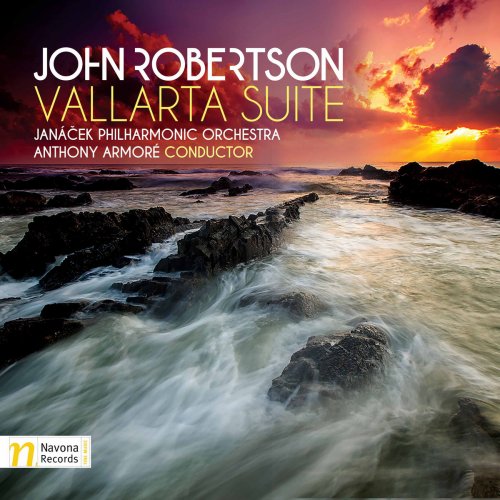Janáček Philharmonic Orchestra & Anthony Armoré - John Robertson: Vallarta Suite, Op. 47 (2017)

Artist: Janáček Philharmonic Orchestra, Anthony Armoré
Title: John Robertson: Vallarta Suite, Op. 47
Year Of Release: 2017
Label: Navona
Genre: Classical
Quality: flac lossless
Total Time: 00:58:44
Total Size: 320 mb
WebSite: Album Preview
TracklistTitle: John Robertson: Vallarta Suite, Op. 47
Year Of Release: 2017
Label: Navona
Genre: Classical
Quality: flac lossless
Total Time: 00:58:44
Total Size: 320 mb
WebSite: Album Preview
---------
01. Vallarta Suite, Op. 47: I. El Malecón
02. Vallarta Suite, Op. 47: II. Las Ballenas
03. Vallarta Suite, Op. 47: III. Excursion para Hacer Compras
04. Vallarta Suite, Op. 47: IV. La Noche en la Zona Romántica
05. Strut In (A March), Op. 34
06. Symphony No. 2, Op. 63: I. Maestoso-Allegro
07. Symphony No. 2, Op. 63: II. Andante
08. Symphony No. 2, Op. 63: III. Passacaglia maestoso
New Zealand born, Canada based composer John Robertson’s album VALLARTA SUITE showcases the continuation of classic orchestral traditions into the present day. The album’s three works testify to Robertson’s flexible compositional voice, which expresses playful, grand, and romantic materials within a welcoming style based on nineteenth century, and early twentieth century precedents. Performed expertly by the Jánacek Philharmonic Orchestra, VALLARTA SUITE is defined by beautiful melodies, confident orchestration, and classic musical forms. The album’s anchors are its multi-movement works, Vallarta Suite, op. 47, and Symphony No. 2, op. 63. Vallarta Suite is a musical postcard to the Mexican city of Puerto Vallarta and, like George Gershwin’s Cuban Overture or Ralph Vaughan Williams’ A London Symphony, uses a variety of contrasting textures and materials to illustrate its geographical subject. For example, the work’s third movement, “Excursion para hacer compras (Shopping excursion)”, is the most concise and literal example of Robertson’s portrayal of Puerto Vallarta. Here, a series of playful and syncopated themes encourage the listener to imagine strolling through the city’s markets. The work’s other movements, namely, “Las Ballenas (The Whales)” and “La Noche en la Zona Romantica (The Night In The Romantic Zone)”, are more abstract and varied in their materials and form. “Las Ballenas”, for instance, is less thematic than other movements, but leans heavily on the orchestra’s brass to express the stately grace of whales. The two other works on VALLARTA SUITE present much more traditional music structures. Strut In – a March, as the title suggests, is Robertson’s take a classic March, and, as one might expect, features jaunty themes and more percussion than is typical to the rest of the album. Unlike Sousa, Robertson crafts a longer, more dramatic structure for his march, and, in particular, uses a wide range of textures to build towards the arrival of its culminating and triumphant melodic material. Robertson’s Symphony No. 2 stands out on VALLARTA SUITE as the only piece that is not wholly defined by a reference to a specific musical style or non-musical reference. Robertson excels in the more abstract setting of the Symphony, the first movement, in particular, is a tremendously crafted voyage of thematic and textural energy. The work’s final movement, “Passacaglia”, suggests, as well, that Robertson always has an eye to the past, as its title refers to a type of instrumental music that originated in the Renaissance. Marked by its grand orchestration, the “Passacaglia” serves as an intense and brilliant finale to the Symphony and VALLARTA SUITE, as a whole. Consider the potential differences between the works based on extra-musical references (i.e. Vallarta Suite and Strut In) and the Symphony, which is more of a statement of ‘absolute music’. There is great consistency in Robertson’s treatment of melodic themes, rhythm, and orchestration across the album, which may act as evidence in assessing his overall compositional style





![Tomasz Stańko - Piece for Diana and Other Ballads (Polish Radio Sessions vol. 1/6) (2025) [Hi-Res] Tomasz Stańko - Piece for Diana and Other Ballads (Polish Radio Sessions vol. 1/6) (2025) [Hi-Res]](https://www.dibpic.com/uploads/posts/2025-12/1765788761_cover.jpg)
![NYO Jazz - Live in Johannesburg (Live) (2025) [Hi-Res] NYO Jazz - Live in Johannesburg (Live) (2025) [Hi-Res]](https://www.dibpic.com/uploads/posts/2025-12/1765894703_zwp14vk90corb_600.jpg)

